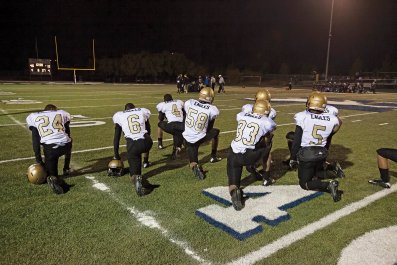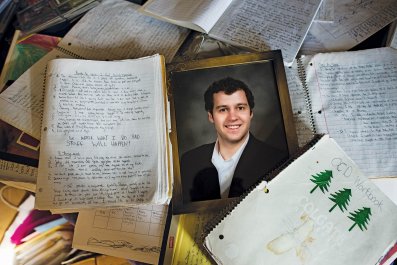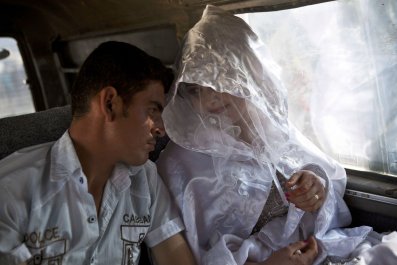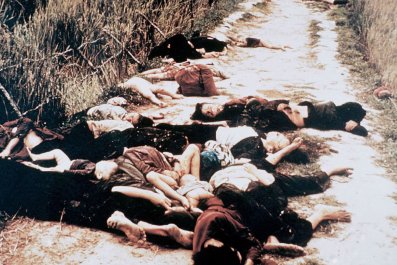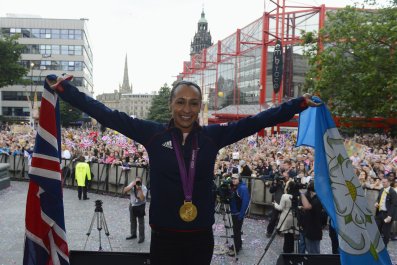Most actors would rather play dead people. This reduces the chance of being seen—and perhaps in this case, judged—by the person you are playing. A cast in a production of Sam Shepard's Fool for Love was once surprised when the playwright's father started kibitzing from the audience, taking issue with what a character based on him was saying. "It didn't happen like that…"
When Supreme Court Justice Ruth Ginsburg came to see the Elevator Repair Service's (ERS) performance of Arguendo in Washington, D.C., in April, she couldn't quibble with the lines. Every word is taken from a recording of the argument before the court in a 1991 case, Barnes v. Glen Theatre, that challenged Indiana's ban of nude dancing. And Susie Sokol, the actress who plays Ginsburg, practically channels the justice after watching videos of her before every show.
"Of course we were terrified at first," says ERS founder John Collins of the Ginsburg visit, "but there is just so much affection in Susie's portrayal of her, and I think she sensed that." Ginsburg adored the show—a slightly surreal, 80-minute reenactment that plays more like one of Robert Smigel's "Fun With Real Audio" cartoons on Saturday Night Live than an episode of C-Span—and invited the celebrated experimental troupe to her chambers the next day.
"We went and thought, We've got to get her a gift!" says Collins. Since Emily Post doesn't cover such eventualities, the cast decided to give Ginsburg the collar Sokol wears in the show—a sort of neck doily like one the justice wears at the throat of her robe to distinguish herself from the men on the bench. (Not like the gold stripes then-Chief Justice William Rehnquist wore on his sleeves, which were to distinguish him from mere mortals.) "We got another one quickly made for Susie," Collins recalls, "and Ginsburg wore the one we gave her in court the next day; she sent us a photograph of herself wearing Susie's collar."
It doesn't get much more meta than that.
Reenacting an argument before the Supreme Court may not sound like most people's idea of a night of great theater, but Arguendo has been selling out as it tours the nation, playing in small performance spaces (it lands in Zurich, Switzerland, next, December 8-10). And ERS gained international attention with Gatz, an eight-hour performance of every word of The Great Gatsby—a prospect that daunted many theatergoers but left many in a state of rapture. (The New York Times's Ben Brantley called Gatz "the most remarkable achievement in theater not only of this year but also of this decade.")
Collins, who directed both productions, came to the Supreme Court arguments via Gatz. Though the company had the permission of Fitzgerald's estate, a previous commitment to another producer prevented ERS from performing in certain theater towns, and Collins was searching for some legal work-around (First Amendment, fair use) when he started listening to recordings of SCOTUS arguments on Oyez and became immediately addicted. He stumbled upon the Barnes v. Glen Theater arguments there, and "just listening to that case I heard theater." The ensemble learned "every little stammer and stutter" of the court, with three actors switching off the roles (if not the robes) of nine justices—which might seem like overkill given that even the biggest legal nerd couldn't tell you what all the justices in the Rehnquist court sound like.
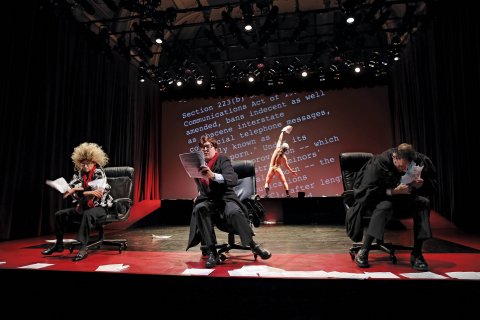
Being obsessive researchers, the members of ERS also read biographies of the justices and the court (Jeffrey Toobin is among those thanked in the acknowledgments) and learned far more than they needed to. "I wanted actors who, even if you didn't understand everything they said, you knew they did," Collins said.
Arguendo is a Latin term meaning "for the sake of argument," and the arguments heard by the Supreme Court when it's in session have been compared by lawyers who have argued there to standing in a shooting gallery. "You need to make sure you don't accidentally concede anything," says Collins. "There is a lot at stake, and the whole point of the interrogation you go through is to see if there are any holes in your argument."
There is nothing comparable in performance except maybe improv, something Collins is terrified of, he tells me. We're sitting in the lobby of a hotel in San Francisco's Tenderloin District as ERS prepares to take Arguendo to L.A. There's a lot of noise as people are checking in and out and kids are playing in the hallway and the director looks a bit like the man in the shooting gallery himself. "I think an audience is always looking for something to go wrong," he says. "And it's exhilarating when that happens. Obviously, we do our best not to make mistakes onstage, but when something goes a little bit differently or an accident happens—not life-threatening—that gets exciting for everybody."
All ERS plays are tightly choreographed (Katherine Profeta, a founding member, is listed as "movement dramaturg," and spinning chairs and moving furniture are part of her signature style)—just as the oral arguments before the court sit on an enormous amount of writing. And when a justice hits you with some left-field question—Justice Anthony Kennedy says, "Suppose somebody wanted to open an adults-only car wash" in Arguendo, while Justice Antonin Scalia keeps trying to bring up opera—it's like a prop falling down onstage or someone blowing a line. "You see the actors thinking on their feet; the audience gets this thrill at seeing something they know no one else has seen. There's a kind of equivalent there in oral argument. It's not just the delivery of a prepared speech; there are things at stake, you don't know how it's going to go live," Collins says.
Such fealty to the text was not always the ERS style. After coming to New York City in 1991 from Yale, where he majored in English literature and theater studies, Collins found work with the Wooster Group, Elizabeth LeCompte's groundbreaking multimedia performance troupe known for taking theater texts and rendering them almost incomprehensible. A lot of ERS projects were sort of "found art"—an autobiographical piece on Andy Kaufman combined the comedian's shtick with some language instruction text they had discovered.
In 1999, they found a project because ERS member Scott Shepherd had been rereading Fitzgerald's novel. The idea of having the cast, who play mostly low-level office workers inhabited by the characters of Gatsby, was inspired, as if the story was in the DNA of all Americans. "The experience for the individual actors, I think, is one of being haunted by their characters," says Collins. "It was a sort of possession almost; they were somebody else, but they were being drawn into this other world."
Though Gatz represented a faithful embrace of an author's words, there was contrast with the setting. The play opens in a rather down-at-the-heels office, filled with piles of paper and outmoded computer monitors. The first man onstage turns on his desktop computer and while waiting for it to boot up, picks up a copy of The Great Gatsby stuck in a Rolodex and starts to read: "In my younger and more vulnerable years, my father gave me some advice that I've been turning over in my mind ever since.…"
The office setting was a mashup of a Garment District print shop ERS used and a funky office space above its downtown theater. "If we had been sitting here, it might have been set in a hotel lobby," says Collins.
Though they never set out to be book interpreters, the group picked another novel after the success of Gatz. Doing exactly the same thing with another short novel seemed too expected, and Collins, like others in ERS, was a fan of Southern literature. (He was born in North Carolina and raised in Georgia.) William Faulkner's The Sound and the Fury seemed like an attractively impossible selection, and their interpretation of the Benjy chapter ("April Seventh, 1928") debuted in April 2008. (The play returns to New York's Public Theater in May 2015.)
The opening chapter of Faulkner's novel is disjointed; it's the "tale told by an idiot," the mentally challenged Benjy Compson, whose recollection of family events is unstuck in time. "We got some help from some academics in Canada," says Collins. "We found a website out of University of Saskatchewan where they had broken down the Benjy chapter into the 21 different episodes being described. And that helped us break it down….
"And after that we said, Let's do one more, make it a trilogy, and we did it in this kind of dumb way: Well, if you draw a line from Fitzgerald to Faulkner, where does it take you? It takes you to Hemingway. So it ended up being kind of the high school reading list." The Select, the company's interpretation of The Sun Also Rises, was not like any high school class you likely attended, but it was more conventional for ERS in the sense that actors played characters from the book, even if it was only a piece of the book. "We allowed ourselves to edit it," Collins says of the process. "We still decided we would commit to using only Hemingway's language—just not all of it. That was a case of rather than treating the novel like a play, which is what we did with Gatz, we looked for a play inside the novel. We were so drawn to the dialogue; Hemingway's dialogue is so sharp, so funny and incisive. That became the basis of that show."
ERS knows that Hemingway might be an easier sell to the Swiss than the U.S. Supreme Court. "People have different degrees of familiarity with the Supreme Court here in this country, but when you say 'First Amendment' everyone knows what that means," Collins says. "This will be a test of the show as a pure piece of theater."
I ask Collins if he knew that Andy Kaufman used to punish audiences by reading The Great Gatsby aloud. "That wasn't what inspired us, but a wonderful coincidence," he says, noting that the comedian never read the whole thing. "Even Andy Kaufman thought that idea was ridiculous."







